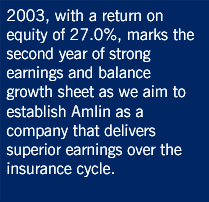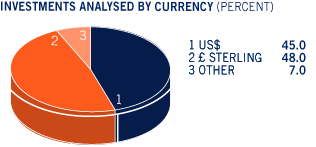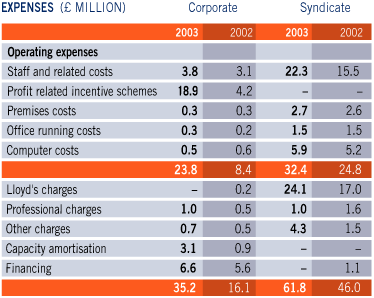|
 |
|
|
 |
|
|
 |
 |
 |
|
PERFORMANCE
Currency management
Approximately 65% of our premium income is written in Euros, US
and Canadian dollars. Currency assets are matched with currency
liabilities. However, foreign exchange risk exists on profits made
in each currency. This is mitigated through a policy of converting
these currency profits to sterling as insurance risk expires.
Given the inherent volatility in some of our business a cautious
approach is adopted on the speed and level of sales, but we seek
to extinguish all currency risk on earned profit during the second
year after the commencement of any underwriting year.
The main currency exposure comes from the US dollar assets.
During 2003 the trading range of the US dollar against sterling
was 1.55 to 1.79, with a significant weakening of the US dollar
in the last quarter. The application of our foreign exchange
management policy meant that US$186 million of anticipated
profits for the 2001 and 2002 years of account were sold during
the year at an average exchange rate of US$1.62. However, as
we do not sell foreign currency until business materially comes
off risk, we had not sold any 2003 year of account dollar profits
at 31 December 2003. The cost of the US dollar weakening
in the last quarter to the 2003 pre-tax profit was £4.3 million.

Expenses (excluding brokerage)
Expenses increased by £37.4 million during the year, comprising
a £18.3 million increase in our share of Syndicate operating
expenses to £59.4 million and a £19.1 million increase in other
charges to £35.2 million.
£7.1 million of the increase in Syndicate expenses was Lloyd’s
costs, mainly the Central Fund levy which ceased at the end of
2003. A further £6.8 million, of which the Company share was
£4.7 million, related to an additional contribution made to the
main defined benefit pension scheme, further details of which
are provided in note 9.
Other charges increased mainly owing to employee incentives,
most of which are profit related. During the year we have accrued,
or paid, an additional £15.5 million for the profit related bonuses
for the 2002 and 2003 underwriting years. In addition a further
£3.4 million has been accrued under the capital builder plan,
which is based on underwriting returns exceeding five year
performance targets, with the total accrual under this scheme
now amounting to £5.9 million.

Cash flow
The growth of the business in a highly profitable environment
has resulted in very healthy positive Syndicate cash flow with
investable funds increasing by £259 million during 2003 to
£1.26 billion at 31 December 2003. Amlin’s share of this
has grown with the increase in its Syndicate ownership.
At a Company level, free cash flow is driven by Lloyd’s three
year accounting system. Accordingly, Amlin anticipates strong free
cash flow commencing in 2005 as profits from the 2002 and
subsequent years are released by Lloyd’s.
Lloyd’s has indicated its intention to change its method of
accounting with effect from 1 January 2005 and this may result
in earlier releases of cash from underwriting years.
International financial reporting standards (IFRS)
Amlin is required to prepare its accounts under IFRS from
1 January 2005.
A full evaluation of the impact of IFRS on the Company was
completed during 2003 which suggested that the current IFRS
proposals, excluding the accounting for insurance contracts
exposure draft, will have little impact on the net asset position
compared to that produced under current UK accounting standards.
However there will be significant increases in disclosure,
particularly with regard to business risk and management.
The accounting for insurance exposure draft may lead to significant
change in the future as it proposes a fundamentally different basis
for recognition of profit on insurance contracts. However this is not
expected to take effect until 2007 at the earliest.
Back to top
|
|
|
|
|
|